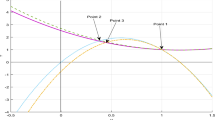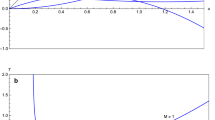Summary
The paper deals with the investigation of thermal effects on the evolution of weak discontinuities and their contributions in the formation of shock waves. The growth and decay behaviour of weak discontinuities has been discussed by taking into account the influence of thermal conduction. The critical stage of shock formation as a result of breakdown has been determined. It is found that the thermal conduction has a destabilizing effect on the propagation of weak discontinuities. Special cases of interest are also discussed to explore the possibilities of the shock formation.
Riassunto
Il lavoro riguarda la ricerca sugli effetti termici sull’evoluzione di discontinuità deboli e i loro contributi nella formazione di onde d’urto. Il comportamento di crescita e di decadimento delle discontinuità deboli è stato discusso prendendo in considerazione l’influenza della conduzione termica. È stato determinato lo stadio critico della formazione d’urto come risultato di una rottura di una discontinuità debole. Si è trovato che la conduzione termica ha un effetto destabilizzante sulla propagazione di discontinuità deboli. Si discutono anche casi speciali d’interesse per esplorare le possibilità di formazione dell’urto.
Резюме
В статье исследуется влияние тепловых эффектов на эволюцию слабых разрывов и их вклады в образование ударных волн. Обсуждается рост и затухание слабых разрывов, учитывая влияние теплопроводности. Определяется критическая стадия образования ударных волн в результате нарушения слабого разрыва. Обнаружено, что теплопроводность оказывает дестабилизирующий эффект на распространение слабых разрывов. Также рассматриваются специальные случаи, чтобы исследовать возможности образования ударных волн.
Similar content being viewed by others
References
G. B. Whitham:J. Appl. Math. Mech.,1, 290 (1956).
E. Wlodarezyk:J. Tech. Phys.,16, 403 (1975).
J. D. Murray:SIAM J. Appl. Math., Vol.18, No. 4, 792 (1970).
W. Bürger:Fluid Dynamics Transactions, Vol.6, Part II (1973). 0134 0240 V 2
E. Becker:Injuri Arch.,39, 302 (1970).
E. Becker:J. R. Aeronaut. Soc.,74, 736 (1970).
E. Becker andH. Schmitt:Injuri Arch.,36, 335 (1968).
A. S. Rai, M. Gaur andR. Ram:Acta Phys. Acad. Sci. Hung.,45(1), 9 (1978).
A. S. Rai andM. Gaur:Acta Phys. Pol. A,57, 653 (1980).
R. Ram andA. S. Rai:Bull. Cl. Sci., Acad. R. Belg., 5th Edition,66, 256 (1980).
V. V. Menon andV. D. Sharma:J. Math. Anal. Appl.,81, No. 1, 189 (1981).
T. Y. Thomas:J. Math. Mech.,6, 455 (1957).
T. Y. Thomas:J. Math. Mech.,6, 311 (1957).
Author information
Authors and Affiliations
Additional information
Traduzione a cura della Redazione.
Перевебено ребакцией.
Rights and permissions
About this article
Cite this article
Rai, A., Pandey, K.S. Behaviour of a weak discontinuity in a thermally conducting gas. Nuov Cim B 85, 94–104 (1985). https://doi.org/10.1007/BF02721523
Received:
Revised:
Published:
Issue Date:
DOI: https://doi.org/10.1007/BF02721523




